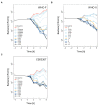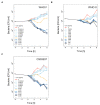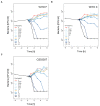Pharmacodynamics of Ceftriaxone, Ertapenem, Fosfomycin and Gentamicin in Neisseria gonorrhoeae
- PMID: 35326763
- PMCID: PMC8944423
- DOI: 10.3390/antibiotics11030299
Pharmacodynamics of Ceftriaxone, Ertapenem, Fosfomycin and Gentamicin in Neisseria gonorrhoeae
Abstract
Objectives: To assess the in vitro effect of select antimicrobials on the growth of N. gonorrhoeae and its pharmacodynamic parameters.
Methods: Time-kill assays were performed on two reference N. gonorrhoeae strains (ceftriaxone-resistant WHO X and ceftriaxone-susceptible WHO F) and one clinical N. gonorrhoeae strain (ceftriaxone-susceptible CS03307). Time-kill curves were constructed for each strain by measuring bacterial growth rates at doubling antimicrobial concentrations of ceftriaxone, ertapenem, fosfomycin and gentamicin. Inputs from these curves were used to estimate minimal bacterial growth rates at high antimicrobial concentrations (ψmin), maximum bacterial growth rates in the absence of antimicrobials (ψmax), pharmacodynamic minimum inhibitory concentrations (zMIC), and Hill's coefficients (κ).
Results: Ceftriaxone, ertapenem and fosfomycin showed gradual death overtime at higher antimicrobial concentrations with a relatively high ψmin, demonstrating time-dependent activity. Compared to WHO F, the ψmin for WHO X was significantly increased, reflecting decreased killing activity for ceftriaxone, ertapenem and fosfomycin. At high ceftriaxone concentrations, WHO X was still efficiently killed. CS03307 also showed a high ψmin for ceftriaxone in spite of a low MIC and no difference in ψmin for fosfomycin in spite of significant MIC and zMIC differences. Gentamicin showed rapid killing for all three strains at high concentrations, demonstrating concentration-dependent activity.
Conclusions: Based on time-kill assays, high-dosage ceftriaxone could be used to treat N. gonorrhoeae strains with MIC above breakpoint, with gentamicin as a potential alternative. Whether ertapenem or fosfomycin would be effective to treat strains with a high MIC to ceftriaxone is questionable.
Keywords: Neisseria gonorrhoeae; antimicrobial resistance; ceftriaxone; ertapenem; fosfomycin; gentamicin; pharmacodynamics; time–kill curves.
Conflict of interest statement
The authors declare no conflict of interests.
Figures





Similar articles
-
In Vitro Efficacy of Gentamicin Alone and in Combination with Ceftriaxone, Ertapenem, and Azithromycin against Multidrug-Resistant Neisseria gonorrhoeae.Microbiol Spectr. 2021 Oct 31;9(2):e0018121. doi: 10.1128/Spectrum.00181-21. Epub 2021 Oct 20. Microbiol Spectr. 2021. PMID: 34668731 Free PMC article.
-
Efficacy of ertapenem, gentamicin, fosfomycin, and ceftriaxone for the treatment of anogenital gonorrhoea (NABOGO): a randomised, non-inferiority trial.Lancet Infect Dis. 2022 May;22(5):706-717. doi: 10.1016/S1473-3099(21)00625-3. Epub 2022 Jan 19. Lancet Infect Dis. 2022. PMID: 35065063 Clinical Trial.
-
Time-kill curve analysis and pharmacodynamic modelling for in vitro evaluation of antimicrobials against Neisseria gonorrhoeae.BMC Microbiol. 2016 Sep 17;16:216. doi: 10.1186/s12866-016-0838-9. BMC Microbiol. 2016. PMID: 27639378 Free PMC article.
-
Neisseria gonorrhoeae and fosfomycin: Past, present and future.Int J Antimicrob Agents. 2015 Sep;46(3):290-6. doi: 10.1016/j.ijantimicag.2015.05.007. Epub 2015 Jun 19. Int J Antimicrob Agents. 2015. PMID: 26145201 Review.
-
Global resistance of Neisseria gonorrhoeae: when theory becomes reality.Curr Opin Infect Dis. 2014 Feb;27(1):62-7. doi: 10.1097/QCO.0000000000000025. Curr Opin Infect Dis. 2014. PMID: 24275696 Review.
Cited by
-
Managing treatment failure in Neisseria gonorrhoeae infection: current guidelines and future directions.Lancet Infect Dis. 2024 Aug;24(8):e532-e538. doi: 10.1016/S1473-3099(24)00001-X. Epub 2024 Feb 14. Lancet Infect Dis. 2024. PMID: 38367636 Free PMC article. Review.
-
Editorial: Antibiotics Special Issue on Pharmacokinetic/Pharmacodynamic Models of Antibiotics.Antibiotics (Basel). 2022 Nov 3;11(11):1540. doi: 10.3390/antibiotics11111540. Antibiotics (Basel). 2022. PMID: 36358195 Free PMC article.
-
Sexually transmitted infections in Spain: Current status.Rev Esp Quimioter. 2023 Oct;36(5):444-465. doi: 10.37201/req/038.2023. Epub 2023 Jun 19. Rev Esp Quimioter. 2023. PMID: 37335757 Free PMC article. Review.
-
A Pharmacodynamic Study of Aminoglycosides against Pathogenic E. coli through Monte Carlo Simulation.Pharmaceuticals (Basel). 2023 Dec 24;17(1):27. doi: 10.3390/ph17010027. Pharmaceuticals (Basel). 2023. PMID: 38256861 Free PMC article.
-
Clinical Studies Are Needed to Determine the Efficacy of Ceftriaxone and Other Interventions in Addressing Resistant Neisseria gonorrhoeae Infection.Sex Transm Dis. 2025 Jan 1;52(1):e1. doi: 10.1097/OLQ.0000000000002069. Epub 2024 Sep 2. Sex Transm Dis. 2025. PMID: 39226080 No abstract available.
References
-
- Eyre D.W., Sanderson N., Lord E., Regisford-Reimmer N., Chau K., Barker L., Morgan M., Newnham R., Golparian D., Unemo M., et al. Gonorrhoea treatment failure caused by a Neisseria gonorrhoeae strain with combined ceftriaxone and high-level azithromycin resistance, England, February 2018. Eurosurveillance. 2018;23:1800323. doi: 10.2807/1560-7917.ES.2018.23.27.1800323. - DOI - PMC - PubMed
-
- Ohnishi M., Golparian D., Shimuta K., Saika T., Hoshina S., Iwasaku K., Nakayama S.-I., Kitawaki J., Unemo M. Is Neisseria gonorrhoeae Initiating a Future Era of Untreatable Gonorrhea?: Detailed Characterization of the First Strain with High-Level Resistance to Ceftriaxone. Antimicrob. Agents Chemother. 2011;55:3538–3545. doi: 10.1128/AAC.00325-11. - DOI - PMC - PubMed
LinkOut - more resources
Full Text Sources

